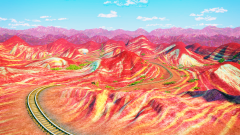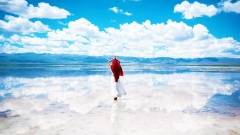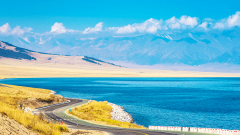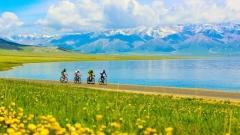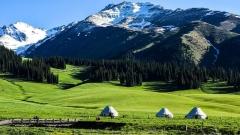Winter in Xinjiang is a season of extremes — vast snowfields, glittering ice, and golden deserts dusted with frost. From skiing in Kanas to exploring frozen lakes and silent sand dunes, Xinjiang offers one of China’s most diverse and visually stunning cold-season adventures. This guide explores the best winter destinations, activities, and practical tips for your unforgettable journey across China’s northwest frontier.
The Beauty of Xinjiang in Winter
Xinjiang transforms into a wonderland between December and February, when the region’s landscapes become even more dramatic. The Altay Mountains in the north are blanketed in snow, ideal for skiing and ice festivals, while the Taklamakan Desert in the south glows golden beneath the crisp winter sun.
Winter also brings quieter travel — fewer tourists, lower prices, and the chance to experience authentic local life.
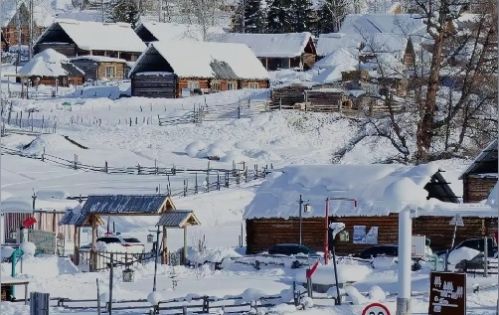
Average Temperatures:
-
Northern Xinjiang (Altay, Kanas, Hemu): –25°C to –10°C
-
Urumqi and Turpan: –15°C to –5°C
-
Southern Xinjiang (Kashgar, Hotan): –5°C to +5°C
Top Winter Destinations in Xinjiang
Altay & Kanas: China’s Northern Ice Kingdom
Known as the “Snow Capital of China,” Altay is where skiing first originated — local herders once used wooden skis thousands of years ago.
-
Kanas Lake: Frozen and surrounded by snow-covered pine forests, it’s perfect for photography.
-
Hemu Village: A postcard-worthy Tuva village where smoke curls from wooden houses in the snow.
-
Altay Ski Resort: One of China’s best ski destinations, with both modern facilities and traditional snow sports.
Tip: Visit between December and February for the clearest skies and best snow quality.

Altay City Ski Resorts
Sayram Lake: The “Last Tear of the Atlantic”
Encircled by snowy mountains, Sayram Lake turns into a massive mirror of ice in winter. Travelers can walk or even ride horses across the frozen lake during the Sayram Lake Ice Festival, which features snow sculptures, ice slides, and local Kazakh performances.

Sayram Lake
Highlights:
-
Ice fishing with locals
-
Kazakh yurts and hot milk tea
-
Frozen sunrise views — ideal for photographers
Nalati Grassland & Bayanbulak
Though famous for summer meadows, Nalati and Bayanbulak in the Ili region offer tranquil, white-covered grasslands in winter. You can spot herders moving through snow, golden light on distant peaks, and herds of horses galloping through the frost.
This is where Xinjiang’s winter feels raw, poetic, and untouched.
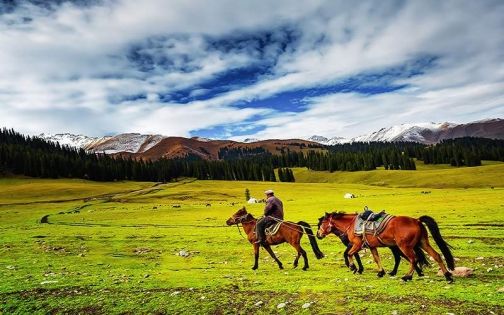
Nalati Grassland
Don’t Miss: Try staying overnight in a Kazakh homestay, warming up by the fire with hand-pulled noodles and milk tea.
Kashgar & the Winter Desert
In southern Xinjiang, Kashgar remains lively and colorful even in the cold. The Old City, with its narrow lanes and mud-brick houses, feels timeless.
-
Explore Id Kah Mosque, Handicraft Street, and Sunday Bazaar without the crowds.
-
Take a day trip to Karakul Lake, where the icy surface mirrors Muztagh Ata, the “Father of Ice Mountains.”
-
Visit the Taklamakan Desert, where sand dunes sometimes shimmer with frost under the winter sun — a surreal blend of fire and ice.
Tip: Kashgar’s winter is relatively mild (around –5°C to +5°C), making it comfortable for sightseeing.
Unique Winter Experiences in Xinjiang
Skiing and Snowboarding in Altay
If you love snow sports, Altay is China’s rising star. Besides the General Mountain Ski Resort, there are also smaller, scenic slopes near Kanas and Hemu, often surrounded by pristine pine forests.
Ice Fishing at Sayram or Fuhai Lake
Join local Kazakh fishermen as they drill holes through thick ice and pull up glistening fish from below — a centuries-old winter ritual.
Horse Riding on Snow
In Ili or Hemu, ride through snowfields like the nomads — wrapped in fur-lined coats and guided by Kazakh horsemen.
Hot Springs in the Snow
After a long day outdoors, soak in one of Xinjiang’s natural hot springs. The Baihaba and Wenquan hot springs are especially popular, surrounded by snow-covered valleys.
Winter Markets & Cuisine
Winter in Xinjiang means hearty food — kebabs sizzling over charcoal, steaming lamb soup, and hot naan bread fresh from the oven. Don’t miss Urumqi’s International Grand Bazaar for warm local snacks and souvenirs.
Practical Travel Tips for Winter in Xinjiang
What to Pack:
-
Layered winter clothing (thermal base, down jacket, windproof outerwear)
-
Snow boots with good grip
-
Moisturizer and lip balm (the air is dry)
-
Sunglasses — the snow glare is strong
-
Portable oxygen for those sensitive to high altitude in northern areas
Transportation:
-
Flights: The fastest way between cities like Urumqi, Altay, and Kashgar.
-
Trains: Xinjiang’s railway network is extensive, with comfortable overnight trains connecting major cities.
-
Road Trips: For adventurous travelers, self-driving along the G217 or G218 highways offers epic winter landscapes — but always check road conditions first.
Accommodation:
Winter is off-season, meaning lower hotel prices and easier bookings, though in remote areas some guesthouses close temporarily. Always confirm before arrival.
Safety & Weather:
-
Northern Xinjiang can drop below –30°C, so avoid long outdoor exposure without proper gear.
-
Roads can be icy — plan extra time for travel.
-
Some scenic spots (like parts of Kanas) may close temporarily due to heavy snow; check updates in advance.
Why Visit Xinjiang in Winter?
While many travelers prefer Xinjiang’s warm summer, winter reveals its most mystical and peaceful side. The crowds disappear, the air turns crystal-clear, and you’ll have the landscapes almost entirely to yourself. Whether you’re chasing blue ice at Sayram, skiing in Altay, or sipping milk tea in a Kashgar bazaar, Xinjiang in winter feels raw, intimate, and utterly unforgettable.
Conclusion
Xinjiang’s winter is not just cold — it’s alive with adventure. From snow-clad forests to frozen lakes and golden deserts, it’s a season that rewards those who venture beyond the usual routes. Embrace the chill, slow down, and let the silence of the vast northwest remind you what true wilderness feels like.



